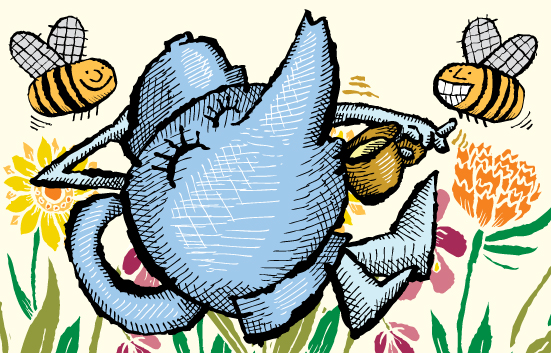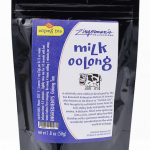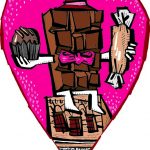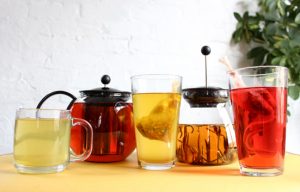
If you’re on a hunt for tea, make Zingerman’s Delicatessen your first stop!
The Deli stocks a wide spectrum of teas: White, Green, Yellow, Oolong, Black (called Red in China), Pu-Erh/Dark Tea (called Black in China), Purple, and Herbal Teas (otherwise known as Tisanes — if you’re fancy).
Our tea specialist makes sure the Deli’s tea selection is diverse, interesting and approachable. You’re bound to find both your old standby and a new favorite when you stop in to peruse our shelves or order a hot or iced tea from Next Door Cafe.
As with everything the Deli stocks, our staff is passionate about learning all of the defining characteristics of the tea we stock. We sat down with our tea expert to learn more about the types of tea, flavor range, caffeine levels, ethics, fair trade designations and new trends that can be found in our multifaceted tea selection.
Types of Tea
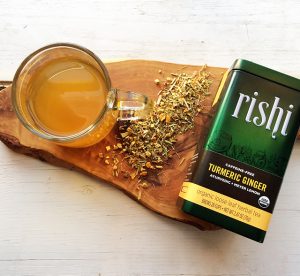 We’re excited to introduce an expanded selection of tea at Zingerman’s Deli. What began as a vision in late Summer 2019, has come to fruition. We brought back long lost favorites and added new representations of the great styles of tea from around the world. We tasted over a hundred different teas in our efforts developing our new collection. While we can’t say we’re finished, we can say with confidence that we have the best selection of teas and tisanes we’ve ever offered at the Deli.
We’re excited to introduce an expanded selection of tea at Zingerman’s Deli. What began as a vision in late Summer 2019, has come to fruition. We brought back long lost favorites and added new representations of the great styles of tea from around the world. We tasted over a hundred different teas in our efforts developing our new collection. While we can’t say we’re finished, we can say with confidence that we have the best selection of teas and tisanes we’ve ever offered at the Deli.
“We are still proud to offer a wide selection of teas from Rishi (many of which are served in the Next Door Cafe), but are now excited about the new partnerships we’ve made with Silk Road, teapigs, Camellia Sinensis and Adagio. In addition, we are delighted to bring you a curated selection of our very own Zingerman’s Deli tea,” our tea specialist said.
For details on the latest and greatest, check out this breakdown of our expanded tea section.
Flavor Range
Tasting through teas is truly a flavor adventure. The wide range of tea we stock translates into a huge, multifaceted selection of flavors. For a taste of how large the spectrum of tea flavors is, take a peek at these flavor wheels designed just for Taiwanese teas.
“If you want to choose on your own, start with a tea you already know and love. Then find something in that category (say, oolong tea) and try it out. Read tasting notes. Does your mouth start watering? That sounds like the tea for you,” our tea specialist said.
Ethical Tea Producers
It can be difficult too find out if a tea is ethically made, but Zingerman’s works directly with import partners and blenders that have direct relationships with the farmers, tea makers, and aging houses (for pu-erh teas).
“When it’s not a pandemic, they travel every year to the farms, the small artisan tea factories, and maturation facilities to maintain those relationships and personally ensure the quality and ethics of the supply chain,” our tea specialist said.
Caffeine Levels
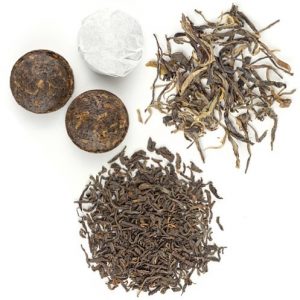
Some guests sip tea to relax, and some reach for their tea for a pick-me-up. The good news is, there’s something for everyone, no matter what caffeine level they’re looking for, in our tea selection.
Caffeine levels are all over the map. As a general rule, black teas and pu-erh tend to be higher in caffeine, green, yellow, and oolong teas somewhere in the middle, and white teas at the lower end of the spectrum. Herbal teas are generally caffeine-free but certain traditional infusions, notably Yerba Mate and cacao shell tea, do contain caffeine.
“Every tea is different. The terroir, the varietal, the farming method, the processing, even that year’s weather can have an impact. As an example, two of our most caffeinated teas are Zingerman’s Darjeeling First Flush and Camellia Sinensis Gyokuro Shizuoka. One is a black tea from high mountains in India, the other is a shade-grown green tea from lower elevations in Japan. And in this case, the green tea has MORE caffeine,” our tea specialist said.
New Trends
As far as future expansion, our tea specialist will continue to taste through teas to inform the section’s stock.
“Matcha is a big thing right now. Yerba mate seems to be up and coming. In the world of traditional tea, teamakers are constantly coming up with new variations and farmers with new varietals. The Golden Eyebrow and Milk Oolong were both introduced in the last 15 years. For barista drinks, matcha is still very popular. We’re starting to see other tea/botanical powders being used for lattes like Hojicha powder or Butterfly Pea Flower powder,” he said.
To scope out our tea selection for yourself, visit our online tea store!

